Ram ProMaster City 2020 Owner's Manual
Manufacturer: RAM, Model Year: 2020, Model line: ProMaster City, Model: Ram ProMaster City 2020Pages: 350, PDF Size: 13.27 MB
Page 261 of 350

258 SERVICING AND MAINTENANCE
The image on the coolant system pressure cap is a
reminder that the radiator contains hot engine
coolant under pressure.
Disposal Of Used Coolant
Used ethylene glycol-based coolant (antifreeze) is a regu-
lated substance requiring proper disposal. Check with your
local authorities to determine the disposal rules for your
community. To prevent ingestion by animals or children, do
not store ethylene glycol-based coolant in open containers or
allow it to remain in puddles on the ground. If ingested by a
child or pet, seek emergency assistance immediately. Clean
up any ground spills immediately. Coolant Level
The coolant expansion bottle provides a quick visual method
for determining that the coolant level is adequate. With the
engine OFF and cold, the level of the engine coolant (anti
-
freeze) in the bottle should be between the “MIN” and
“MAX” marks.
The radiator normally remains completely full, so there is no
need to remove the radiator/coolant pressure cap unless
checking for engine coolant (antifreeze) freeze point or
replacing coolant. Advise your service attendant of this. As
long as the engine operating temperature is satisfactory, the
coolant bottle need only be checked once a month.
When additional engine coolant (antifreeze) is needed to
maintain the proper level, only OAT coolant that meets the
requirements of FCA Material Standard MS.90032 should be
added to the coolant bottle. Do not overfill.
WARNING!
• Do not open hot engine cooling system. Never add engine coolant (antifreeze) when the engine is over -
heated. Do not loosen or remove the cap to cool an over -
heated engine. Heat causes pressure to build up in the
cooling system. To prevent scalding or injury, do not
remove the pressure cap while the system is hot or
under pressure.
• Do not use a pressure cap other than the one specified for your vehicle. Personal injury or engine damage may
result.
2020_RAM_PROMASTER_CITY_OM_USA=GUID-7B6A7FCA-79B0-423F-95C5-ED2A949C3D13=1=en=.book Page 258
Page 262 of 350
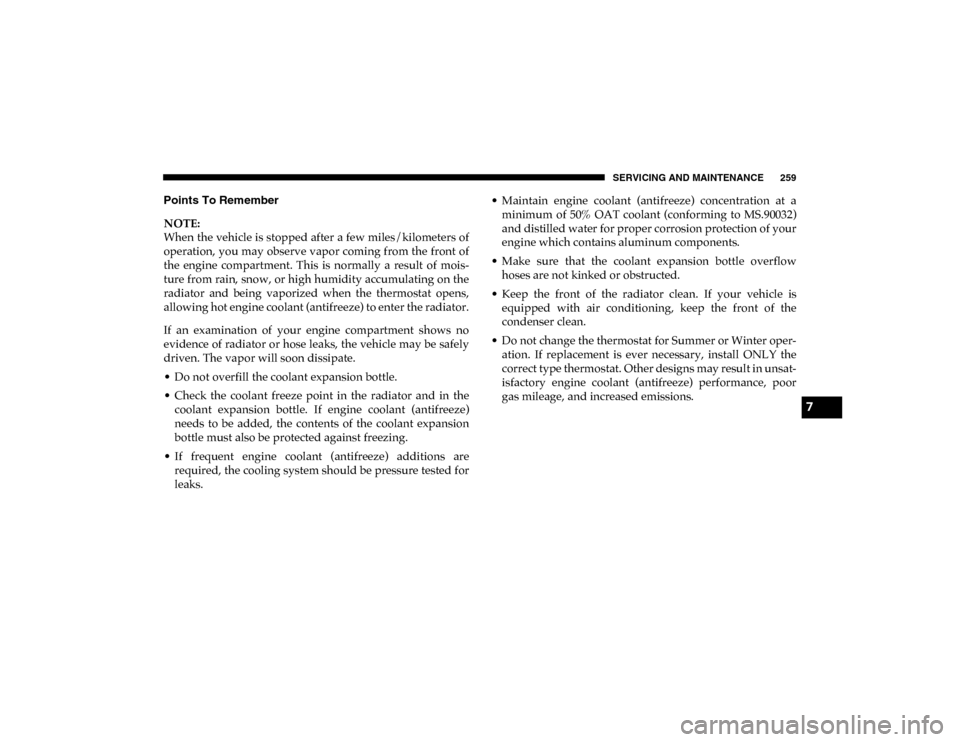
SERVICING AND MAINTENANCE 259
Points To Remember
NOTE:
When the vehicle is stopped after a few miles/kilometers of
operation, you may observe vapor coming from the front of
the engine compartment. This is normally a result of mois-
ture from rain, snow, or high humidity accumulating on the
radiator and being vaporized when the thermostat opens,
allowing hot engine coolant (antifreeze) to enter the radiator.
If an examination of your engine compartment shows no
evidence of radiator or hose leaks, the vehicle may be safely
driven. The vapor will soon dissipate.
• Do not overfill the coolant expansion bottle.
• Check the coolant freeze point in the radiator and in the coolant expansion bottle. If engine coolant (antifreeze)
needs to be added, the contents of the coolant expansion
bottle must also be protected against freezing.
• If frequent engine coolant (antifreeze) additions are required, the cooling system should be pressure tested for
leaks. • Maintain engine coolant (antifreeze) concentration at a
minimum of 50% OAT coolant (conforming to MS.90032)
and distilled water for proper corrosion protection of your
engine which contains aluminum components.
• Make sure that the coolant expansion bottle overflow hoses are not kinked or obstructed.
• Keep the front of the radiator clean. If your vehicle is equipped with air conditioning, keep the front of the
condenser clean.
• Do not change the thermostat for Summer or Winter oper -
ation. If replacement is ever necessary, install ONLY the
correct type thermostat. Other designs may result in unsat -
isfactory engine coolant (antifreeze) performance, poor
gas mileage, and increased emissions.
7
2020_RAM_PROMASTER_CITY_OM_USA=GUID-7B6A7FCA-79B0-423F-95C5-ED2A949C3D13=1=en=.book Page 259
Page 263 of 350
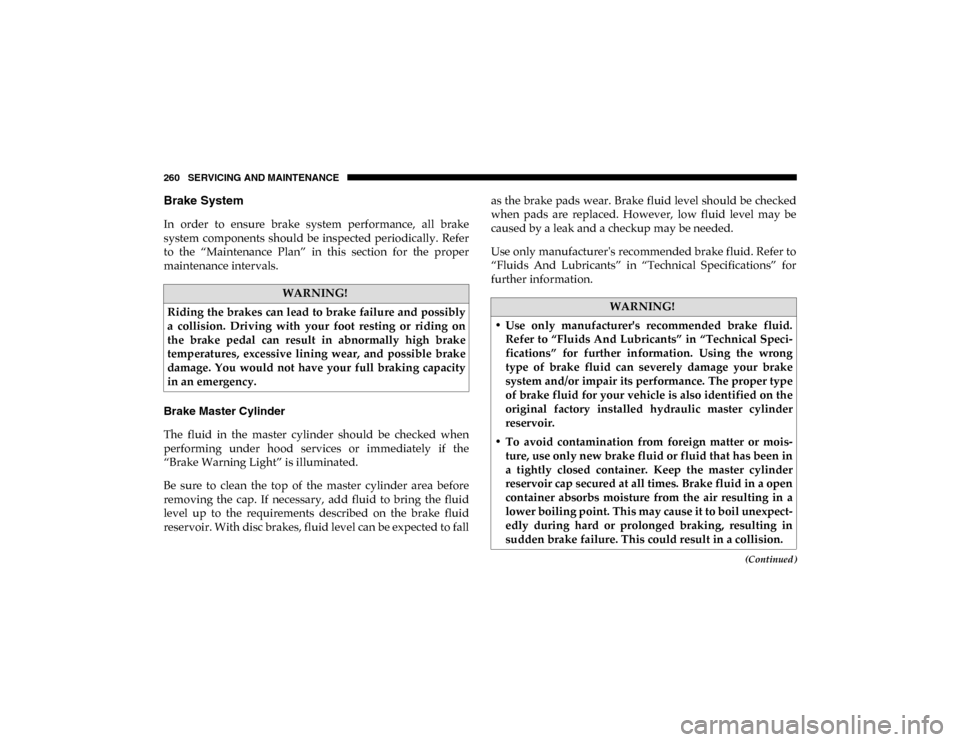
260 SERVICING AND MAINTENANCE
(Continued)
Brake System
In order to ensure brake system performance, all brake
system components should be inspected periodically. Refer
to the “Maintenance Plan” in this section for the proper
maintenance intervals.
Brake Master Cylinder
The fluid in the master cylinder should be checked when
performing under hood services or immediately if the
“Brake Warning Light” is illuminated.
Be sure to clean the top of the master cylinder area before
removing the cap. If necessary, add fluid to bring the fluid
level up to the requirements described on the brake fluid
reservoir. With disc brakes, fluid level can be expected to fallas the brake pads wear. Brake fluid level should be checked
when pads are replaced. However, low fluid level may be
caused by a leak and a checkup may be needed.
Use only manufacturer's recommended brake fluid. Refer to
“Fluids And Lubricants” in “Technical Specifications” for
further information.
WARNING!
Riding the brakes can lead to brake failure and possibly
a collision. Driving with your foot resting or riding on
the brake pedal can result in abnormally high brake
temperatures, excessive lining wear, and possible brake
damage. You would not have your full braking capacity
in an emergency.
WARNING!
• Use only manufacturer's recommended brake fluid. Refer to “Fluids And Lubricants” in “Technical Speci -
fications” for further information. Using the wrong
type of brake fluid can severely damage your brake
system and/or impair its performance. The proper type
of brake fluid for your vehicle is also identified on the
original factory installed hydraulic master cylinder
reservoir.
• To avoid contamination from foreign matter or mois -
ture, use only new brake fluid or fluid that has been in
a tightly closed container. Keep the master cylinder
reservoir cap secured at all times. Brake fluid in a open
container absorbs moisture from the air resulting in a
lower boiling point. This may cause it to boil unexpect -
edly during hard or prolonged braking, resulting in
sudden brake failure. This could result in a collision.
2020_RAM_PROMASTER_CITY_OM_USA=GUID-7B6A7FCA-79B0-423F-95C5-ED2A949C3D13=1=en=.book Page 260
Page 264 of 350
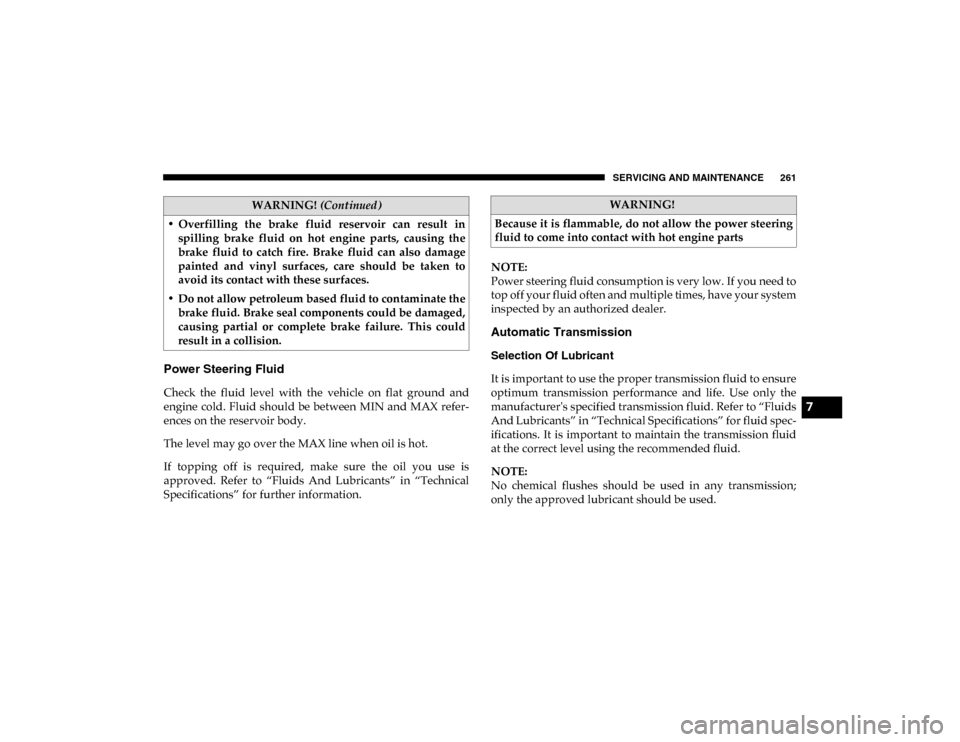
SERVICING AND MAINTENANCE 261
Power Steering Fluid
Check the fluid level with the vehicle on flat ground and
engine cold. Fluid should be between MIN and MAX refer-
ences on the reservoir body.
The level may go over the MAX line when oil is hot.
If topping off is required, make sure the oil you use is
approved. Refer to “Fluids And Lubricants” in “Technical
Specifications” for further information. NOTE:
Power steering fluid consumption is very low. If you need to
top off your fluid often and multiple times, have your system
inspected by an authorized dealer.
Automatic Transmission
Selection Of Lubricant
It is important to use the proper transmission fluid to ensure
optimum transmission performance and life. Use only the
manufacturer's specified transmission fluid. Refer to “Fluids
And Lubricants” in “Technical Specifications” for fluid spec
-
ifications. It is important to maintain the transmission fluid
at the correct level using the recommended fluid.
NOTE:
No chemical flushes should be used in any transmission;
only the approved lubricant should be used.
• Overfilling the brake fluid reservoir can result in
spilling brake fluid on hot engine parts, causing the
brake fluid to catch fire. Brake fluid can also damage
painted and vinyl surfaces, care should be taken to
avoid its contact with these surfaces.
• Do not allow petroleum based fluid to contaminate the brake fluid. Brake seal components could be damaged,
causing partial or complete brake failure. This could
result in a collision.
WARNING! (Continued)WARNING!
Because it is flammable, do not allow the power steering
fluid to come into contact with hot engine parts
7
2020_RAM_PROMASTER_CITY_OM_USA=GUID-7B6A7FCA-79B0-423F-95C5-ED2A949C3D13=1=en=.book Page 261
Page 265 of 350

262 SERVICING AND MAINTENANCE
Special Additives
The manufacturer strongly recommends against using any
special additives in the transmission. Automatic Transmis-
sion Fluid (ATF) is an engineered product and its perfor -
mance may be impaired by supplemental additives.
Therefore, do not add any fluid additives to the transmis -
sion. Avoid using transmission sealers as they may
adversely affect seals. Fluid Level Check
The fluid level is preset at the factory and does not require
adjustment under normal operating conditions. Routine
fluid level checks are not required; therefore the transmis
-
sion has no dipstick. An authorized dealer can check your
transmission fluid level using special service tools. If you
notice fluid leakage or transmission malfunction, visit an
authorized dealer immediately to have the transmission
fluid level checked. Operating the vehicle with an improper
fluid level can cause severe transmission damage.
CAUTION!
Using a transmission fluid other than the manufacturer’s
recommended fluid may cause deterioration in
transmission shift quality and/or torque converter
shudder. Refer to “Fluids And Lubricants” in “Technical
Specifications” for fluid specifications.
CAUTION!
Do not use chemical flushes in your transmission as the
chemicals can damage your transmission components.
Such damage is not covered by the New Vehicle Limited
Warranty.
CAUTION!
If a transmission fluid leak occurs, visit an authorized
dealer immediately. Severe transmission damage may
occur. An authorized dealer has the proper tools to adjust
the fluid level accurately.
2020_RAM_PROMASTER_CITY_OM_USA=GUID-7B6A7FCA-79B0-423F-95C5-ED2A949C3D13=1=en=.book Page 262
Page 266 of 350
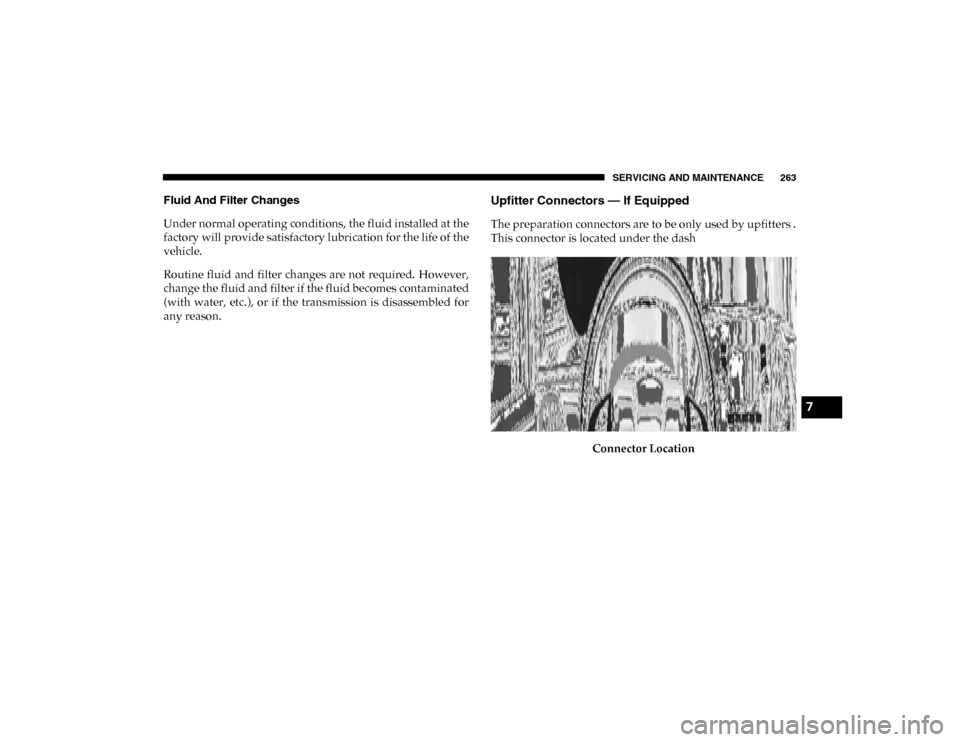
SERVICING AND MAINTENANCE 263
Fluid And Filter Changes
Under normal operating conditions, the fluid installed at the
factory will provide satisfactory lubrication for the life of the
vehicle.
Routine fluid and filter changes are not required. However,
change the fluid and filter if the fluid becomes contaminated
(with water, etc.), or if the transmission is disassembled for
any reason.Upfitter Connectors — If Equipped
The preparation connectors are to be only used by upfitters .
This connector is located under the dashConnector Location
7
2020_RAM_PROMASTER_CITY_OM_USA=GUID-7B6A7FCA-79B0-423F-95C5-ED2A949C3D13=1=en=.book Page 263
Page 267 of 350

264 SERVICING AND MAINTENANCE
15 Way Vehicle Connector Functions and ViewConnector Pin Numbers Upfitter Connector
PIN
Function
1 Not Connected
2 Alternator System Charging In Process Signal
3 Vehicle Speed Repetition (VSO) 4 Not Connected
5 Not Connected
6 Not Connected
7 Additional Courtesy Light8 Courtesy Lights Negative Control (Dimmed)
9 Not Connected
10 Not Connected
11 Not Connected
12 Not Connected
13 Power Supply At Key On (+Ignition) 14 Not Connected
15 Not Connected
2020_RAM_PROMASTER_CITY_OM_USA=GUID-7B6A7FCA-79B0-423F-95C5-ED2A949C3D13=1=en=.book Page 264
Page 268 of 350
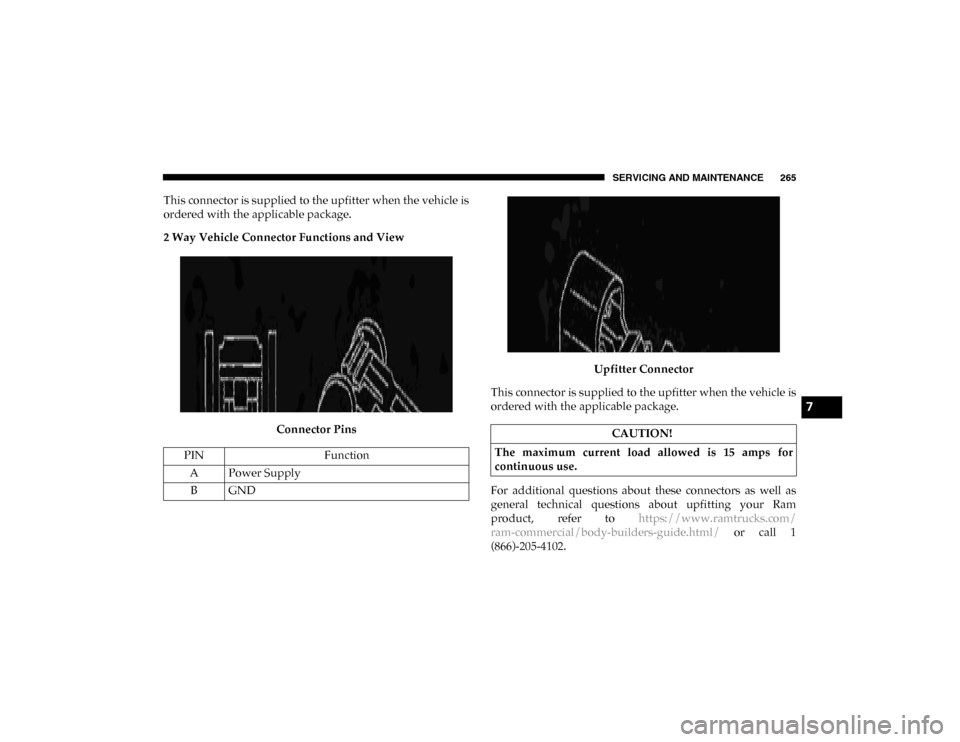
SERVICING AND MAINTENANCE 265
This connector is supplied to the upfitter when the vehicle is
ordered with the applicable package.
2 Way Vehicle Connector Functions and ViewConnector Pins Upfitter Connector
This connector is supplied to the upfitter when the vehicle is
ordered with the applicable package.
For additional questions about these connectors as well as
general technical questions about upfitting your Ram
product, refer to https://www.ramtrucks.com/
ram-commercial/body-builders-guide.html/ or call 1
(866)-205-4102.
PIN
Function
A Power Supply B GND
CAUTION!
The maximum current load allowed is 15 amps for
continuous use.
7
2020_RAM_PROMASTER_CITY_OM_USA=GUID-7B6A7FCA-79B0-423F-95C5-ED2A949C3D13=1=en=.book Page 265
Page 269 of 350
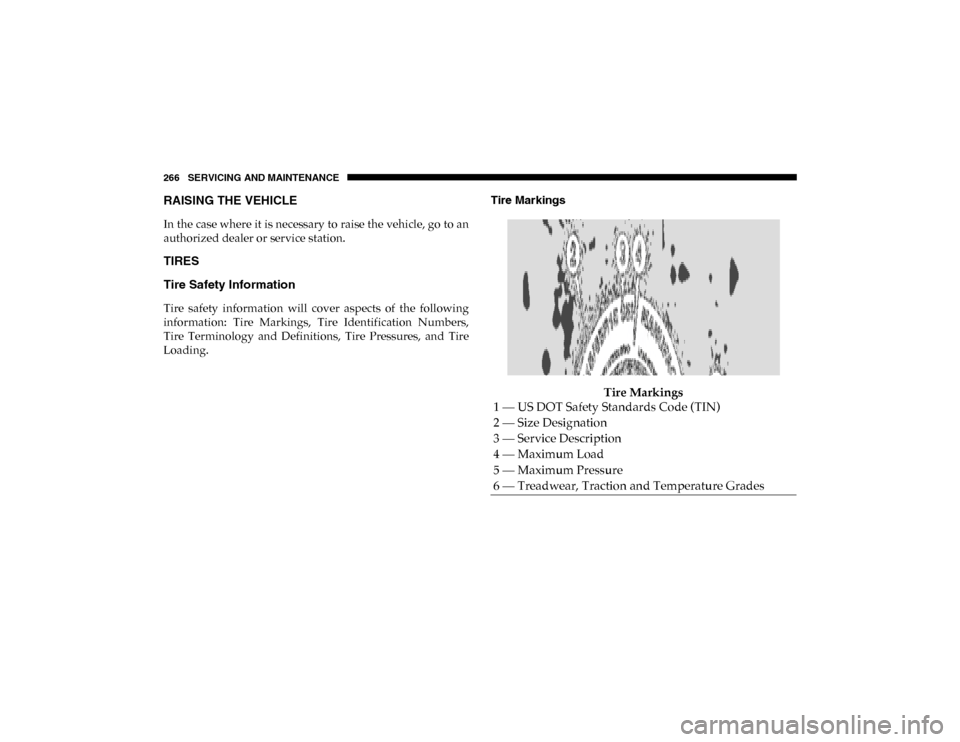
266 SERVICING AND MAINTENANCE
RAISING THE VEHICLE
In the case where it is necessary to raise the vehicle, go to an
authorized dealer or service station.
TIRES
Tire Safety Information
Tire safety information will cover aspects of the following
information: Tire Markings, Tire Identification Numbers,
Tire Terminology and Definitions, Tire Pressures, and Tire
Loading.Tire Markings
Tire Markings
1 — US DOT Safety Standards Code (TIN)
2 — Size Designation
3 — Service Description
4 — Maximum Load
5 — Maximum Pressure
6 — Treadwear, Traction and Temperature Grades
2020_RAM_PROMASTER_CITY_OM_USA=GUID-7B6A7FCA-79B0-423F-95C5-ED2A949C3D13=1=en=.book Page 266
Page 270 of 350
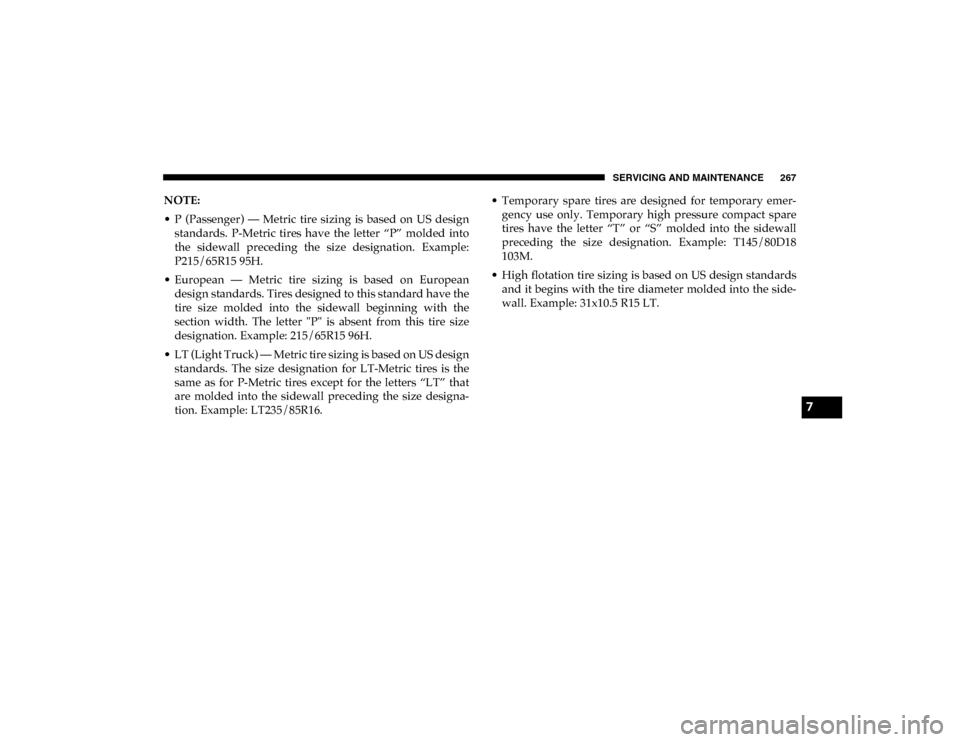
SERVICING AND MAINTENANCE 267
NOTE:
• P (Passenger) — Metric tire sizing is based on US designstandards. P-Metric tires have the letter “P” molded into
the sidewall preceding the size designation. Example:
P215/65R15 95H.
• European — Metric tire sizing is based on European design standards. Tires designed to this standard have the
tire size molded into the sidewall beginning with the
section width. The letter "P" is absent from this tire size
designation. Example: 215/65R15 96H.
• LT (Light Truck) — Metric tire sizing is based on US design standards. The size designation for LT-Metric tires is the
same as for P-Metric tires except for the letters “LT” that
are molded into the sidewall preceding the size designa -
tion. Example: LT235/85R16. • Temporary spare tires are designed for temporary emer
-
gency use only. Temporary high pressure compact spare
tires have the letter “T” or “S” molded into the sidewall
preceding the size designation. Example: T145/80D18
103M.
• High flotation tire sizing is based on US design standards and it begins with the tire diameter molded into the side -
wall. Example: 31x10.5 R15 LT.
7
2020_RAM_PROMASTER_CITY_OM_USA=GUID-7B6A7FCA-79B0-423F-95C5-ED2A949C3D13=1=en=.book Page 267